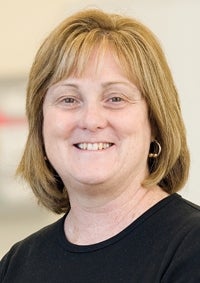For years, experts have warned of shortages of health care professionals, and guidance counselors have responded by steering talented students toward the lucrative nursing, health technician and dental fields.
Now, with the economy in bad shape, health care stands out even more, growing jobs as fast as other industries lose them.
Yet for many local colleges, preparing the steady swarm of young people looking to enter the health fields presents some significant difficulties.
Recruiting new faculty to teach expanding classes is no easy matter, and neither is finding hospitals where students can get hands-on experience.
Record Numbers
“The college just had our fall open house, and we certainly had record attendance for the college in general, and definitely for the nursing program,” said Linda McKay, chair of the nursing department at Fitchburg State College.
McKay said interest in health fields at FSC has been rising for the past seven years or so, but with the economy down it’s even more obvious now.
For one thing, more people are looking at state colleges as a cost-saving option, and, for another, rising projections about the value of a health degree draw more people toward the field.
But McKay and others at local colleges said it’s hard to find teachers to lead all the classes they’d like to offer.
Several noted that a new RN graduating with an associate’s degree can often earn more at a hospital than an experienced nurse with a master’s can make teaching.
At Quinsigamond Community College in Worcester, administrators have gone at least a little way toward addressing that disparity.
Jane June, dean of health care at QCC, said that a couple of years ago the college’s leadership agreed to boost nursing faculties’ pay by $4,000, even though teachers in other areas weren’t getting a similar raise.
June said many instructors also supplement their income by working in hospitals during the summer or in their off hours.
“Is it equal? No, it is not,” she said. “But people love to teach, so people find a way to do it.”
Added Flexibility
Thomas Connelly, director of the associate nursing program at Anna Maria College in Paxton, said the teaching schedule itself is also a big plus for many instructors who have children at home. The program runs year-round, so teachers can work any two semesters and then take one off, whether it’s the summer, spring or fall.
“To say you’ll have the fall off or the spring off is a tremendous opportunity for them to be part of the life of their family,” he said.
Still, McKay said the academic schedule also has its downside. While clinical nurses can go home and relax after eight or 12 hours of intensive work, teachers tend to bring work home with them.
Besides, she said, many nurses don’t want to bother getting the master’s degrees and PhDs that most schools want, and those that do often end up becoming researchers in hospitals.
Finding places for students to get hands-on experience has also been a perennial problem for health science programs.
While hospitals are eager to help develop the workforce they need, educators said it’s often difficult to find the slots.
Several said a database created by the Department of Higher Education a few years ago has been a huge boon in placing students.
The tool helps match hospital departments with room for students with the program that need clinical spots.
“That has certainly facilitated the process,” Connelly said. “It’s a wonderful peer-reviewed system.”
But many colleges are still having trouble with clinical placements.
Nancy Duphily, director of nursing at Mount Wachusett Community College in Gardner, said that, rather than wait for spots at hospitals, the college is now placing students at high-acuity units in rehabilitation facilities, nursing homes and step-down units.
“Quite frankly, that’s where many of the students are going to be practicing,” she said.
At Fitchburg State, McKay said, the school has actually been able to reduce the number of hours that students need to spend in clinical settings by offering more realistic ways to practice in a lab.
It uses electronic mannequins to let students have clinic-like experiences right at school.
“It will certainly never take the place of the clinical setting, but it’s helpful to augment their learning,” she said.
Input and Output
Not all efforts to graduate more health science professionals are based on increasing capacity. June said QCC changed its admission requirements in October with an eye toward increasing retention.
“If you’re taking 50 and you’re graduating 30, you don’t need to increase your enrollment by 20,” she said. “You need to retain them.”
She said Quinsigamond’s attrition rate of 30 to 45 percent is not unusual for health programs, but the college hopes to bring it down to 25 percent.
Besides upping the admission requirements, she said, it’s also providing more support for enrolled students.
June said the school also encourages students who are wait-listed in popular programs like nursing and dental hygiene to apply in other areas like surgical technician and respiratory care where there may be open spots.
Similarly, Duphily said Mount Wachusett recently began suggesting that applicants who don’t get into the RN program apply to train in licensed nursing. She said a number of students have taken the school up on the idea.
“That worked very well for us,” Duphily said. “They’re a decent pool of students that are doing very well.”
Schools have also ramped up programs for people already working in health care. At MWCC, LPNs can get credit for their experience, take a few classes over the summer and enter the second year of the RN program in the fall.

